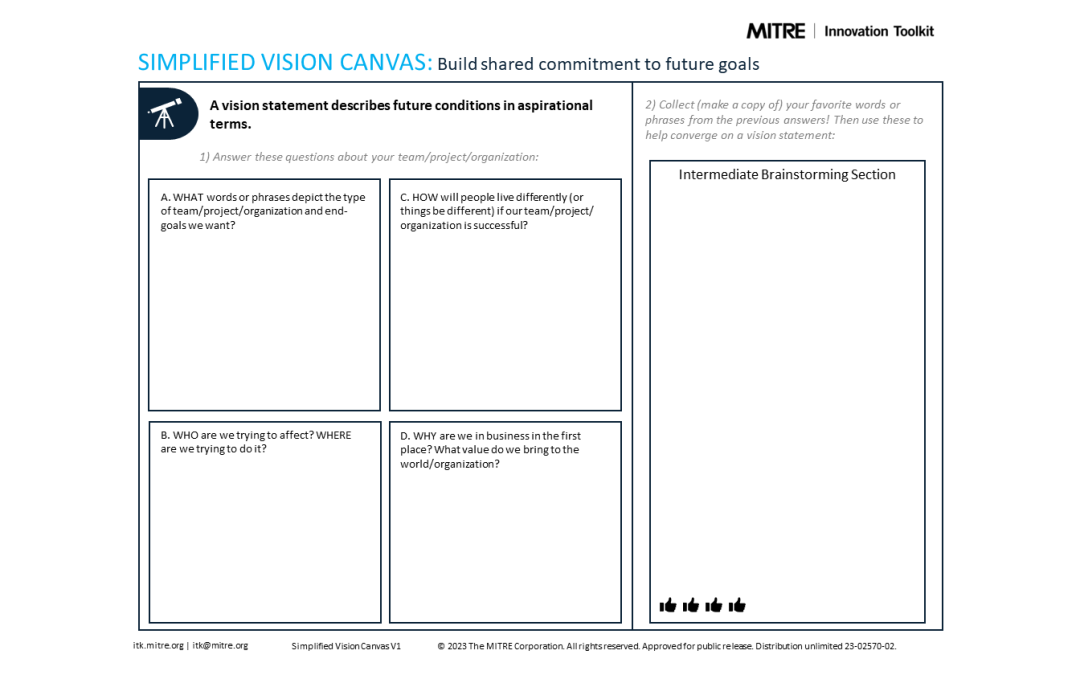This post is by Allison Khaw, an ITK Facilitator at MITRE.
The original Mission & Vision Canvas is a staple of the Innovation Toolkit—it addresses a common need, it’s impactful, and it’s fun.
The Mission & Vision Canvas helps you develop new Mission and Vision statements or refine existing ones. A Mission is meant to be implementation-focused; it “describes present activities in concrete terms”. In contrast, a Vision is meant to be everlasting and inspiring; it “describes future conditions in aspirational terms”.
Even for tools that are well-established like this one, periodic revisions are usually worthwhile. Change is inevitable, after all, and evolving a product can have long-term benefits.

In early 2023, Gabby Raymond (another ITK Facilitator) and I discussed ways that the Mission & Vision Canvas could be improved, starting with the “Vision” half. We had used the tool a number of times, and we had ideas.
As we began experimenting, our ideas morphed into actual design changes. We wanted a clearer focus on “what”, “how”, “who”, “where”, and “why”; to do this, we redesigned the prompts to capture them as more informative questions. In order to reduce the barrier to entry, we added more helper resources, including a word bank and a variety of Vision templates. We also revisited the “Quality Check” and provided a fresh set of Mission and Vision examples from other companies. We even wanted a bigger intermediate brainstorming space!
All of this came from experience, but at the same time, it wasn’t obvious from day one—it took considerable time to articulate what we were looking for. Our intent was never to create a completely new tool, but rather to create an updated tool that highlighted the best parts of the original one while bringing forward complementary improvements to streamline the experience. With this in mind, we created the Simplified Vision Canvas.
How did we find our way to this updated tool? What follows is a set of six reflections on what worked best for us. Hopefully, this will prove valuable for your own projects!
1. Do your research. At the start, Gabby and I analyzed numerous Mission and Vision statements previously created using the Mission & Vision Canvas, as well as Mission and Vision examples from various companies. We looked for similarities in content and format, gauging ones that worked well and ones that didn’t. We also sought out general advice on developing Mission and Vision statements, eager to learn everything we could.
2. Build off of what already exists, rather than trying to create something from scratch. I want to emphasize again that we were intentional about keeping the foundational aspects of the Mission & Vision Canvas, because we knew it worked, and we didn’t want to lose that. Based on our practical experience, we focused on the parts of the tool that we believed should be modified. We simply wanted to make something already great even better.
3. Recognize that a low level of consistent progress is better than no progress at all. We worked on the Simplified Vision Canvas as a side project over seven months, assigning ourselves “homework” in between monthly meetings. Sometimes it’s easy to assume that a lack of substantial time to work on a task means you should wait to start. However, our incremental progress was key to finishing what we set out to do. We were “slow but steady”! (Just like the tortoise in the beloved fable… In fact, What if the Tortoise and the Hare Did a “Rose Bud Thorn”?) Looking back now, seven months was a more than reasonable amount of time to spend updating this tool. Discipline won over anything else here, and it was a lesson well learned.
4. Bring in test users to give feedback early and often. Once Gabby and I had created an initial version of the Simplified Vision Canvas, we held a test session with a small group of ITK team members and received valuable feedback. In hindsight, we probably could have held even more user sessions, earlier in the development process. Additionally, we focused most of our energy on updating the tool itself, but we could have benefited from doing targeted marketing to maximize the number of end users. A lesson learned for our next project? Absolutely. (Also, go use the tool!)
5. Develop your product/tool with a partner. Creating the Simplified Vision Canvas as a team of two, rather than a team of one, was markedly more effective—not to mention more fun. Our collaboration made us de facto accountability partners, and we benefited from diversity of thought. The end product would not have looked anything like it does today without our combined inputs. What’s more, working on a team allowed us to focus on the parts of the process that we were each most passionate about. Truly, it’s a win-win.
6. Adjust your expectations as you go, so that you can tie the bow on your product/tool and then dive into your next creative project. Gabby and I chose the “Vision” half of the original tool to update first, given that a high-level Vision statement is typically where a user would start. Although we aspired to update the “Mission” half of the tool next… we simply didn’t get to it. Oops! We may revisit this in the future, or we may not. Either way, I feel proud of what we did put together while also appreciating the potential for follow-on work.
Looking to try out the Simplified Vision Canvas yourself? There’s a free PDF version; a free and editable PowerPoint version (found on the bottom of the right side of the original Mission & Vision Canvas web page); and a reusable Mural template for MITRE users. Best of luck pursuing your very own Vision goals!

